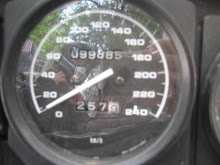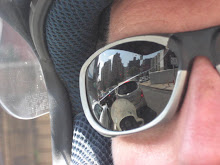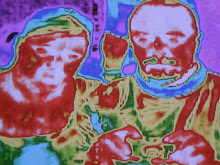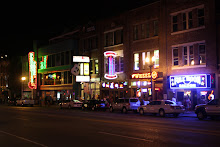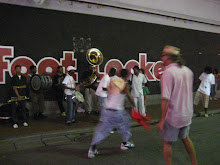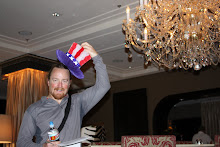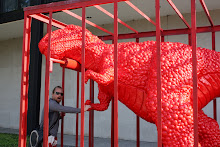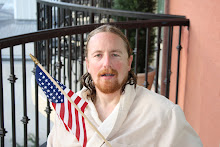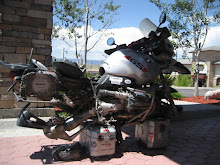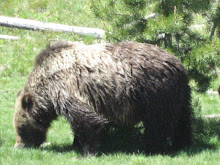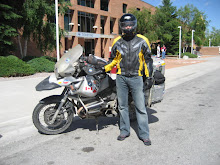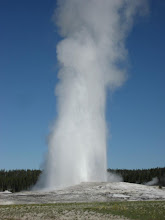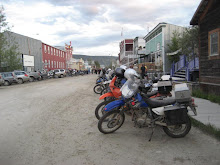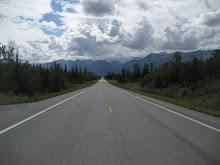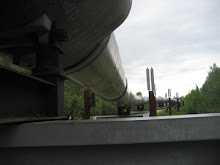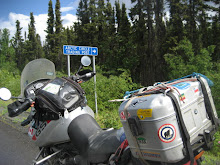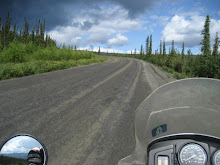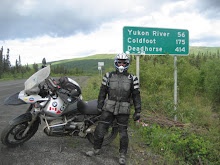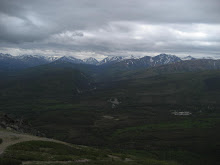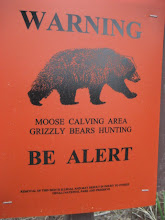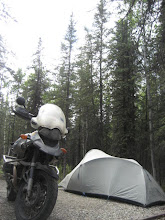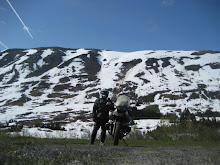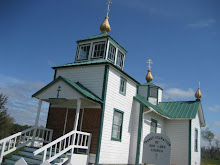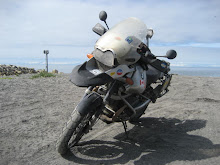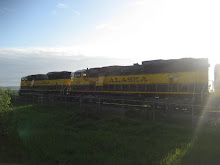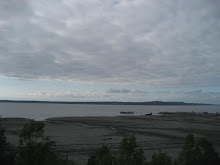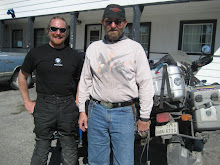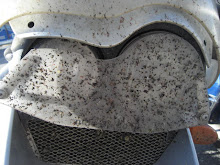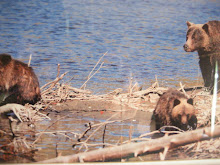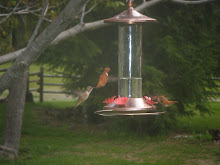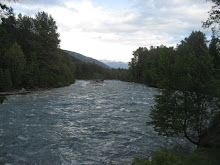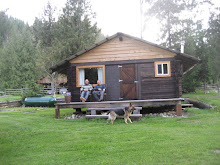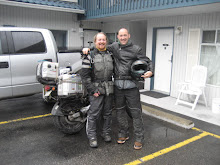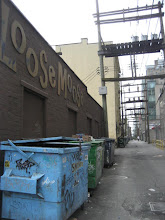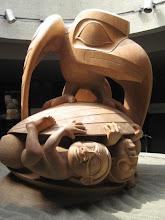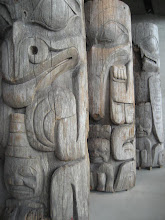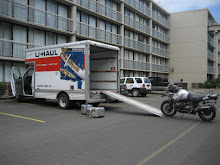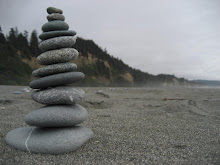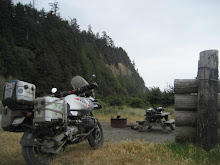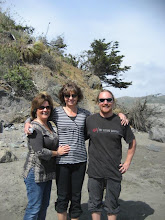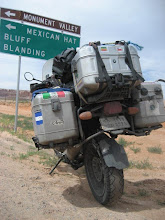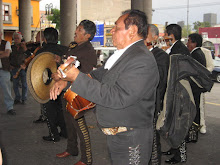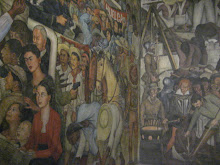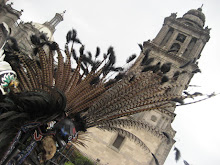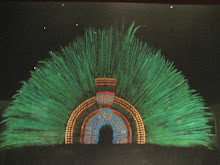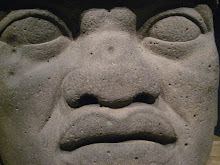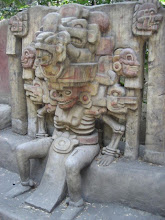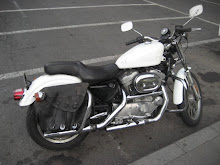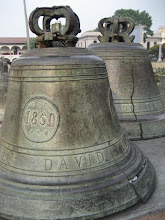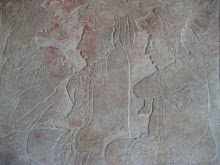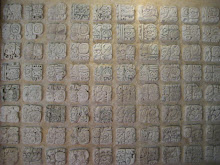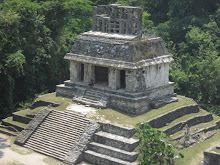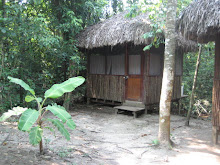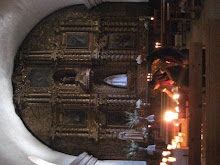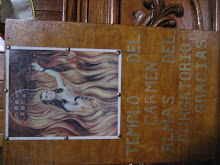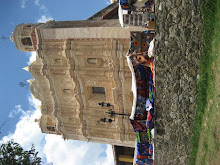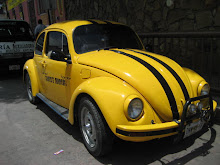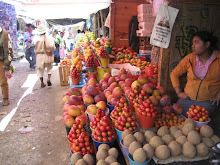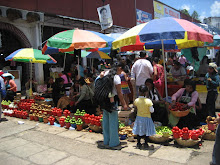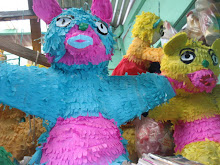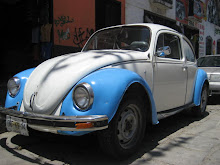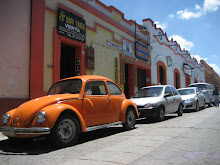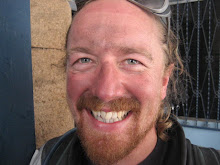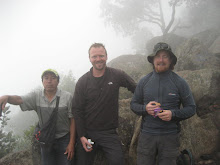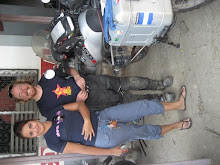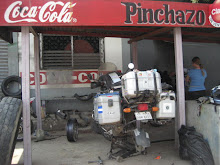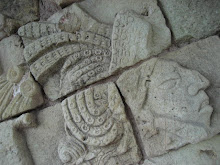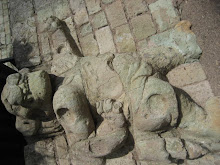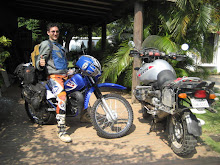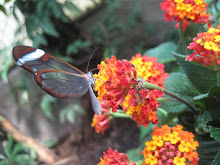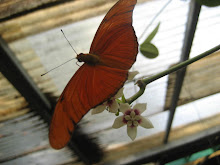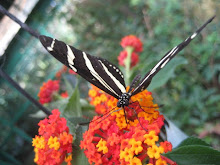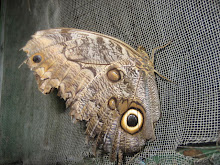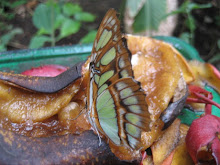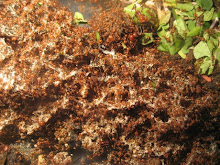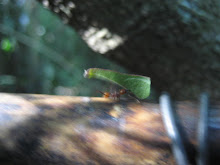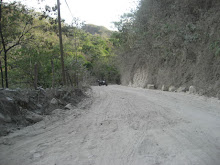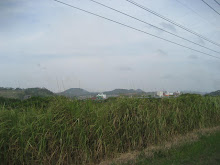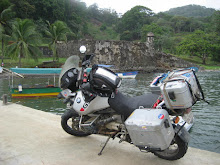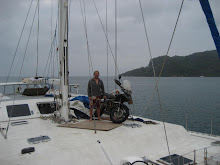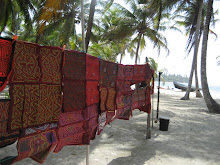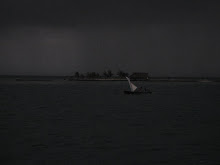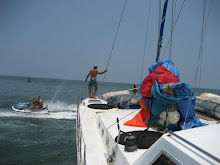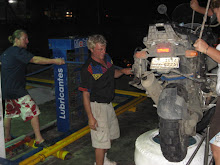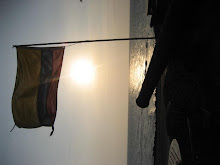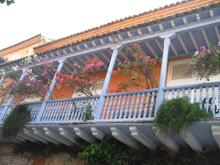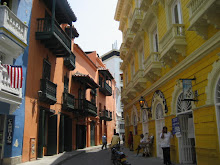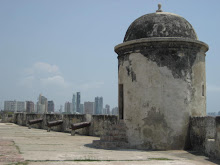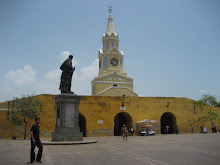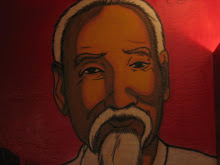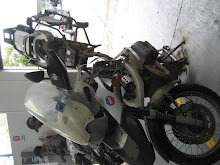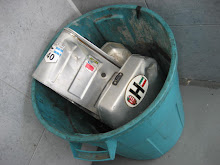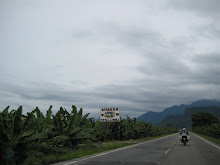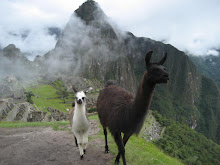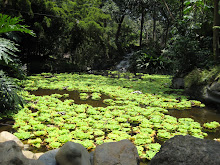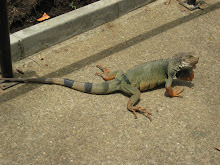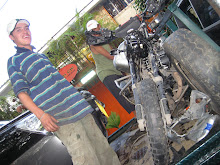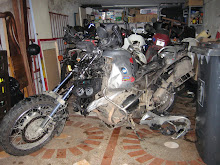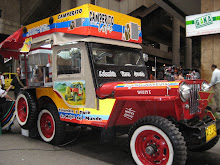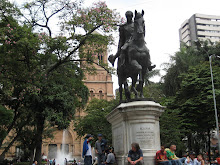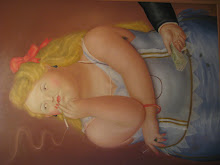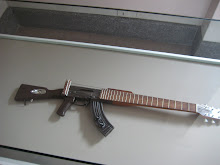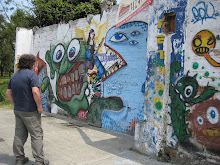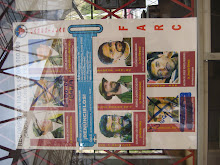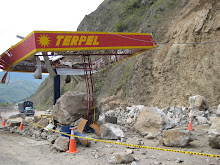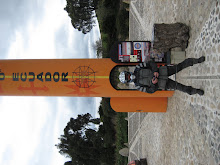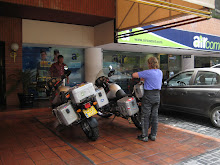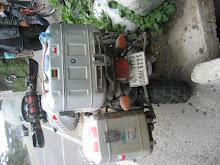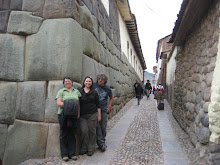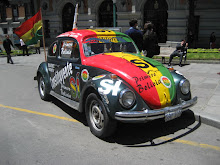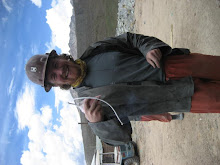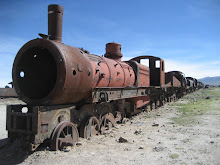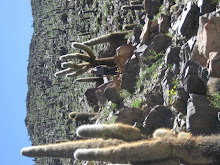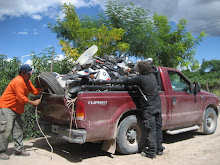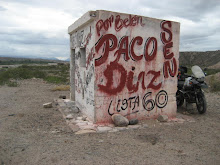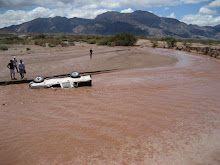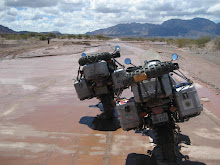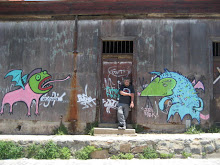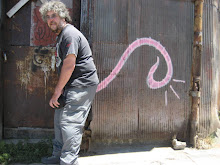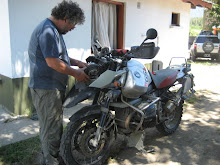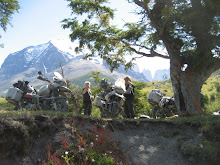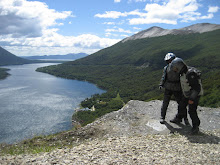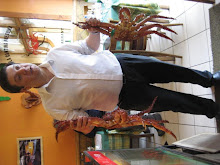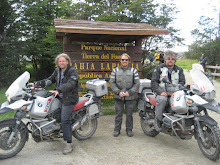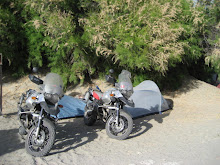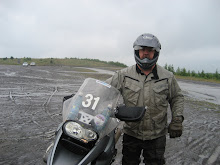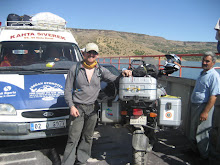After spending the day touring Cartagena, I met the Mystic Wind and the rest of the crew at the fuel dock so we could get the bike on board. Just riding the bike on to the narrow concrete jetty over the fuel lines and water hoses everywhere was hairy enough, so imagine how fast my heart was pounding when we started to winch it on board. Hoisted from 3 lines suspended from the mast, it wasn't long before my GS was over the rail and we were strapping it down against the deck and 2 of the mastcables. I celebrated by cracking open the crate of Erdinger I had bought for the journey, sharing them out amongst tehe rest of the crew, they didn't last the evening. Later on, it turned out that Denis's agent had not been able to get my Carnet de Passage stamped, so rather than delay our departure the next morning, I did it myself with an etamperia de fechas I bought from a Papeleria in Cartagena and a 50 centavos piece soaked in the ink from a broken biro, which had a great official looking crest on it.
In the morning, I stowed my boxes in a fore hatch, above a dented hull which was letting in some water, which had hit a half submerged shipping container a couple of year's ago, and like a lot on the Mystic Wind, was awaiting repair. This included a toilet with a broken pump, a dinghy that had a puncture down one side and was more patch than dinghy and rotting wooden panelling through the entire lower deck, which, along with the toilet, gave the whole boat a heady whiff below decks. In fact the whole effect was a bit like the Black Dog, Captain Pugwash, Master Bates, Seaman Stains and Roger the Cabin Boy were all present and correct.
Captain Denis is a great bloke, who really went the extra mile to help me out. Although he is a rough diamond, who enjoys the sauce, he did rub some people up the wrong way (e.g. Kyle who left early from Porvenir after an argument with him) he reminded me of a cross between the lead singer of the New York Dolls and Captain Jack Sparrow, often pissed and / or stoned, always opinionated but a heart of gold. His friend and Colombian shipmate, Angel, did most of the technical work on the boat with the sails, anchor etc, but was a much better communictor and coach than the skipper, so he taught me a lot about navigating, steering, etc around the Mystic Wind. He was pretty much nocturnal, taking the helm at night and spending most of the day coked up and or sleeping, waking at midday and immediately mixing a strong cuba libre in litre measuring jug, downing one and then sipping another slowly. I never saw him eat anything on the whole 6 day crossing. One night when we were up together steering, he confided in me that he had a terminal cancer, which seemed to explain his easygoing personality and self destructive substance abuse. Adam is an American who seems to have spent the last few years drifting around Latin America after a messy divorce. He had overstayed his visa in Colombia and Denis had agreed to use his fixer to get him an exit stamp without having to pay the fines. Quite a small bloke, he seems sensitive of his size and overcompensates by talking loudly (as most Americans seem to), recently getting a big tattoo, working out. His inferiority complex was manifested openly when he baulked at Denis chiding him for mistakes, although protesting the loudest, he actually seemed to put up with the most abuse from the skipper. So much so, that he confirmed my masochist theory and was going to stay and work with Denis for a little while longer. .
Kyle was a chilled out Canuck, the main source of weed on the boat and someone that everyone seemed to get along with, which is probably why Denis took an exception to him. Jens is an East German guy who was on a round the world bicycle trip, although I realised after talking to him that all the cyclists that I had seen so far on this trip, mostly are not actually cycling the whole way, but do like Jens and cherry - pick the best bits and use buses and planes to get in between. He was a keen motorcyclist too, and had bought a korean off - road bike to do the whole of Australia on before getting back on the bicycle in Valparaiso and really helped a lot getting the bike on and off the boat. Gia and Terese were the final compliment of the crew, 2 Norwegian ladies who mostly kept themselves to themselves, mainly becuse they spent most of the time being seasick and taking up most of the limited deck space...
The first part of the journey was the worst. After leaving Cartagena through Boca Grande, over the modern 5 metre gap in the Spanish Submarine wall, we were out in the open and despite being a catamaran, the dodgy engine (sometimes it started, sometimes it didn't and it often overheated) and our reliance on the single jib sail (the mainsail was "being repaired") started to show. At the end of the day, as the sun was setting and the gibbous moon was rising, it was very disheartening to still be able to see the high rises of Bocagrande clearly behind us on the eastern horizon. The crew were getting mutinous after a day of seasickness and Captain Jack Sparrow was under some pressure. Ill - advisedly, he opened up a debate about what we should do from thereon in. Maybe now we will be getting off at Karti and not Portobelo, closer along the Panamanian coast? My only concern on this plan was the poor mountain and jungle road to Panama City and how do I get my bike off of the launch and onshore with no dock? Then I have to get into Panama City and sort out the paperwork. One good thing is that at least this way, if we don't go into Portobelo as planned, then I will avoid having to go through Colon, which is one of the most dangerous cities in the world, where people get shot and robbed in the street in daylight according to the Lonely Planet Central America.
The most disconcerting thing was all the debate and the constant lack of clear planning and communication. Also, it is so difficult when travelling with others, all with different timeframes and agendas. Captain Jack wants to get pissed and see his girlfriend, Angel wants to keep the peace and get high with the single - minded dedication of someone who knows they have a terminal illness, Adam wants to spend time with people who will talk to him, the Scandinavians want to see a desert island, Kyle wants to see Panama City before catching his flight back to Canada and Jens wants to stick to the original plan, because that is what was agreed originally, and that is the most important thing if you are German. I guess that the constant changes in plan are actually intended as exhuberant and excited suggestions from the skipper on a high, and, eventually, we do follow the basic plan agreed before departure from Cartagena.
Criticised for poor food, poor hygiene, poor safety and yet I thought Denis still had added charming and disarming vulnerability and niaivety to the whole proceedings. We actually ran out of water on the last day, which is unforgiveable on such a short crossing. Luckily we had a big sack of green, sour oranges, which we ate about 8 each during the day to slake our thirsts. One sail and an unreliable engine, meant the journey took longer than it should and was much rougher as we were getting bobbed about by the waves, rather than having the speed to sail over them or with them. Consequently, on the second morning, I overtightened the straps on my bike, subsequently realising that I had bent the side stand, so now my bike has an unnerving tendency to topple over onto the boxes on the side at alarmingly frequency.
Despite it all, I did enjoy the crossing. Steering the boat at night was good fun, following a course of 240 degrees, following the wind to the west and keeping the mast between the setting full moon and the rising constellation of Orion, with all 7 of the Pliedes visible in the great light quality was magical. Also the San Blas Islands were a highlight. We landed in Porvenir, the capital of this autonomous region to get our entry visas. This process involved drinking too much Abuelo Rum with the Immigration Officer, paddling back in the lurching half - inflated dinghy to the boat moored in the lagoon during a tropical storm and casting off to Chichame. Chichame was an archetypal desert island, where we hung around with Puna and Umberto, the matriarch and patriarch of this branch of the Kuna tribe. The Kunas claim to be the only indigenous tribe in Latin America that was never subjugated by the Spanish. This is mainly due to their living in the San Blas archipelago, 366 small coral islands with deadly reefs in between, which made it difficult for them to be pinned down. The women still wear traditional garb, consisting of mola embroidery and beadwork worn on the legs and arms.
After eschewing the dinghy and swimming ashore from the lagoon, enjoying some cold Balboa beers and spear - fishing for Grouper and Red Snapper, we came ashore and had a feast of the fresh fish, lentils and coconut rice that we cooked on the Kuna's kitchen fire. We all get back on board in the evening, only to realise that we hadn't paid for our drinks. When I volunteer to go and settle up with Umberto, it is interesting to see who's notes are rolled up into tubes in their pockets!? There was a strong current, which was easier to deal with in one of the Kuna dug out canoes that I borrowed, even though it was inherently unstable and balanced on a knife - edge, than in our newly patched dinghy when I went to settle up and go for the last beer run of the evening. Denis came too, keen for more beers. When we went into their hut to pay, it was pretty cosy, with everyone sitting under the electric bulb and chatting or sewing more mola whilst swinging from hammocks.
Next day, we rounded Isla Drake under a full moon, entering Portobelo at night, rowing the half inflated dinghy, still more patch than dinghy, the repair failing to have stemmed the escape of air. Portobelo is indeed a beatiful harbour where Colombus sought shelter on his 3rd and final journey to the Americas in 1502 and where the wreck of the abandoned Vizcaina has recently been located by marine archeologists. Now little more than a down at heel tropical village with a protected anchorage and a small concrete jetty on top of oil barrels, converted into supporting columns, Portobelo was once the northern terminus of the Camino Real. Here Peruvian treasure and Bolivian precious metals were stored in huge bonded warehouses and loaded onto Spanish - bound caravels, travelling in annual Armadas for security after being transported across the isthmus from Panama City by mule train. A British visitor, in 1637, Thomas Gage, wrote that it took 30 days for that year's cargo to be loaded onto the ship after passing through the Royal Contaduria or Customs House, which still stands impressively, if incongrously, in the middle of the modern grocery shops, bars and fried chicken joints, now serving as a musuem.
The natural bay is also dotted with ruined defensive walls, forts and towers poking periodically through the tropical forest canopy. Still impressive in scale, after centuries of neglect and with thousands of tons of rock taken to be used in construction of the Panama Canal at the end of the nineteenth century. Needless to say, reports of this wealth attracted the Pirates, with Drake and Morgan both having targetted Portobelo for their own particularly unethical brand of tourism, taking more than photos and leaving a trail of destruction behind them. Portobelo proved to be Drake's downfall when he died here of dysentery in 1596. the local legend had it that he was buried on Isla Drake, although this turned out to be false as it is a rocky outcrop that would be impossible to bury anyone on. Recently discovered documents revealed that he was buried with honours at sea, just beyond the mouth of the harbour in a lead lined coffin. Apparently, Plymouth City Council had sponsored another team of marine archeologists to locate, recover and return his remains to his home town.
Entering the town, it seemed to me that Portobelo also managed to retain elements of its historical levels of hygiene as we toured the town after docking at around 9pm and rowing in from the Mystic Wind in its half - inflated dinghy. Having said that, having not had a proper wash for more than a week myself, I didn't feel in a position to criticise! We indulged in picante fried chicken, with fried bananas and papas and managed to protect ourselves from stomach bugs with a combination of ice - cold Balboas and shots of Ron Abuelo. Soon our land legs started to feel a bit wobbly and after successfully averting Denis's enthusiasm for getting my bike off there and then in the dark, because the tide was high, we paddled back to the Mystic Wind and spent our last night on her decks.
Up early in the morning to unload my bike into Porferio's launch and then haul the bike out onto the concrete jetty, I pay to get it filled with petrol from jerry cans at the grocery store and washed to get the worst of the sea salt off. I agreed with Denis to give him a lift to Colon so he could see his girlfriend if he helped me find the customs office. We got there by 11am, only to be told that the only Customs Officer that could help us was "at lunch" and we should come back in a couple of hours. So, I took Denis into Colon, where we met his girlfriend and her mother outside their tenement building and went for a Lebanese meal. Colon lived up to its reputation, with smoking shells of cars and staggering shells of men, littering the rubbish strewn streets at midday. Lots of men were carrying machetes and openly brandishing guns of all types, without a policeman to be seen. The builings all used to be brightly painted and were originally built for the workers on the Panama Canal, Paul Gauguin amongst them, but were now peeling and literally falling down after more than a century in the unforgiving tropical heat.
Denis offered to come back to the customs office with me, if I gave him a lift on to Panama City in what turned out to be a 5 hours wait for Maria Vargas, Customs Officer. Eventually we got going, I dropped off Denis halfway to Panama City as the sun was going down and headed on in the dark as the Transisthmus Highway collapsed in the gathering gloom into a jungle tunnel, electric with the deafening sound of cicadas. Parrots and parakeets were swooping everywhere, congregating on the power lines at the side of the road. There were also a lot of bats attracted to my headlights, at least I thought they were bats until one of the enormous grasshopper / locust thingies landed on my shoulder with a thud and took a lot of wrestling to "flick" off. Hot, tired, dehydrated and now scared, I decided not to fight through the traffic of Panama City, but took the opportunity to stay opposite the Miraflores locks in a hall of residence attached to the Cuidad de Saber, City of Knowledge Campus.
Whilst unpacking my bike, it had toppled off its sidestand, so I went back outside later in my board shorts and a T shirt for 5 minutes, checking to see if I could adjust it so the bike didn't keep toppling over. There was nothing obvious to be done, but in the process I got harrassed and bitten all over my exposed skin (legs, feet, arms, hands and face) by loads of mosquitoes. Given that this is a prevalent malarial area, along with Yellow Fever too (in fact the disease was identified first in Panama) I scarpered quickly to itch and scratch at my leisure in my room.
Next day after a shower (!) I toured Panama City, checking out a temporary Rembrandt exhibit and visiting the statue to Balboa, Vasco Nunez not Rocky, who was the first to cross the Isthmus and discover the Pacific at the beginning of the sixteenth century and gave his name to the national beer and the centavo divisions of the USD that form the national currency. Then I checked out the Miraflores locks, with the massive container ships, incongruously passing through the humid jungle. Panama City was pretty unremarkable, with Singapore style modern anonymous high rises, although with some seedier areas in betwee at the lower levels.
I was hot and sweaty again by the afternoon and so was pleased when it became time to meet up with Denis, Negrita, Angel and Adam in a bar in the rougher part of Panama Viejo. The bar was an open garage, with a half wall in one corner to block off the drain which provided for the only toilet facilities for men only and the bar was a cage where bottles of beer or rum could be bought. We went to a casino in the newer, cleaner and more sterile part of town, which again reminded me of Hong Kong or Kuala Lumpur or somewhere else in Asia, because of its modernism and humidity. Not enjoying the casino, having had enough of the too sweet for me rum and too tasteless and gassy for me lager, I snuck out to avoid a big farewell and got a taxi back to Miraflores.
Next day (Sunday) I was out early to beat the city traffic and the heat, crossing the Puente de las Americas over the canal that physically seperates the Americas and on towards the cool of the Chiriqui Highlands. On the way, there were 2 half - hearted attempts by the Panamanian police to extort money from me for speeding. It seemed that once I had given them my Dubai licence and explained that I was "Gales", they either got confused or disheartened that I wasn't American. I get the distinct impression than the Yanks hand over the cash far more readily when challenged by Latin America's finest, sworn to serve themselves and protect their bank balances, thus making it tougher for the rest of us gringitos.
I was heading to an "eco -resort" which sounded great, but once I got there, despite being told the opposite, they did not have secure parking for my bike. It took half an hour to scramble up the mountainside in all my bike gear, leaving my bike on the road to discover this. With a considerable bead and mint on, I decided to ride on the lovely sweeping, cool mountain roads towards the resort of Bocas del Toro. When I got there mid - afternoon, I didn't fancy that either as it was very hot on the Caribbean coast and full of double - baggers, so I went on back through the mountains on some more lovely roads and ended up at the Pasos de Canoas border crossing, before I knew what was happening I was out of Panama and into Costa Rica.
Costa Rica is the first place in the trip so far where I HAD to buy insurance and show my Yellow Fever certificate, before getting all the necessary stamps. I went on a further 25km and stopped at a hotel in Ciudad Nelly, with secure parking and a reassuringly bark - inclined dog. I got into town to a chicken joint and realised that contrary to my previous impression, Costa Rica does not officially use USD, but has its own currency, the Colone. Going to the Banco National ATM, I withdrew 5000 colones, not really knowing how much this was (later finding out this was 10 USD) and went back to the Chicken joint, which, in common with every other place I went to in Costa Rica, reassuringly had pickled chillis, hot sour sauce and hot sweet sauce on the table. After having scoffed and spiced myself up, I went back to the hotel and collapsed into a coma.
Next day, up early, I stopped off for a great breakfast of frijoles negras, huevos fritos y pan fresca and was on my way to San Jose on a beautiful section of the Panamericana. Alpine quality blacktop, combined with sweeping mountain roads through cool cloud forest, zig - zagging across the continental divide. Through the unremarkable San Juan, with the help of a biker called Raul.
He led me through the low - rise streets destroyed by several earthquakesand lacking any significant colonial Architecture. Despite the hopeful name given by Colombus, there was little mineral wealth discovered here by the Spanish and so they didn't build big here, dsitracted by the hoards of Oro y Plata elsewhere. In a strange twist of fate, this history has allowed Costa Rica to develop a much more cohesive society than the rest of the region, avoiding the worst divisions of wealth and race suffered elsewhere and enjoying the longest continuous democratic system in Latin America. Ticos are direct and irreverant, for instance, when I frequently lost Raul in the traffic, when I did catch up, he said, "hey man, where were you? I thought you stopped for a coffee or lunch or so'thing". They are more direct too, a bit like the Yanks, with lots of people approaching me at the garage whilst filling up and comments about how much my bike cost (again, vehicles are horrendously expensive in Costa Rica) and how I must have a lot of money to do this trip.
Coming off the Panamericana at San Ramon I headed up towards the mountain coolness of La Fortuna. Passing through the town in the late afternoon I proceeded on ripio to Lago Arenal. I found a great campsite on the shores of the lake and tried out Neil's tent for the first time - very comfortable and very spacious! I got some great apocalyptic visions of the active Vulcan Arenal through the evening cloud from the lakeside campsite, with trails of fiery lava clearly visible rolling slowly down the perfect igneous cone. Next day I was up predictably early and rode through to Tilaran on the toughest dirt trails since Argentina. My luggage got shook off the bike at one point, on a steep hill, which had a lot of big rocks on it, treachourously covered in a talcum powder fine fesh fesh. It was hard to prop up my bike on a rock on the steep hill with its dodgy sidestand and reload, in fact, it was hard to even stand up on the slippery, dusty slope. After a few hours I made it to Santa Elena and checked into the lovely Arco Iris Eco Resort. This time, parking was easily available and there were some of the most barkingest dogs to look after the bike too.
I have spent the past few days enjoying the wildlife and the local cloudforest reserve. I went on a trip to one place with zip wires and bridges built through the canopy (Neil would have hated it) and also a couple of hikes through the Monteverde Reserve nearby. Just being in the trees was immediately relaxing and there was a lot of interesting wildlife to see too. As far as snakes are concerned, I saw a bright green side - striped pit palm viper and a menacing fer de lance up close. Loads of big spiders, insects and birds too, primary amongst them the resplendent Quetzal - national bird of Guatemala, name of its currency and the inspiration for the most important god for the Mayans and Aztecs, Quetzalcoatl, the plumed serpent or half bird, half snake. It is not clear whether this is a literal reference to the Quetzal's flowing tail feathers and swooping flight pattern, which look somewhat like the lower half of a snake's body or whether it is a more fantastic combination of two animals into one deity. Loads of lovely hummingbirds and butterflies too (principle amongst them the magnificent Blue Morpho), both of which I struggled in vain to capture on camera.
Today in the reserve, a family troop of Howler Monkeys were travelling fast nearby through the canopy. Smelt them and then heard them and then saw them, identifying the dominant male easily from his size and distended white testicles, which were disturbingly easy to view from the ground. The cloud forest is distinctly different to Rain forest and surprisingly termperate and comfortable to walk around. Lots of great bromeliads, heliconas, leanas and others became familiar. The latter in particular were fascinating, due to their habit of strangling trees to death over a period of 50 - 60 years, after which the tree rots away and leaves a hollow exo - skeleton of vines behind. These hollow trees are great for climbing up inside, with convenient criss-crossed handholds that allow you to get high up into the the canopy to see bird's nests and leaf - cutter ant's nests up close. Monteverde is on the continental divide the lower spine that connects the Andes and the Rockies, and this particular micro - climate makes a great place to stop, relax and connect with a bit of the natural world for a while.
Tomorrow I am off to meet Em and Hame in Managua at Salvatore's house, Salcar Motos, famous on Horizons Unlimited for his hospitality to bikers after he completed a round the world trip himself. We are going to catch up for a beer or five after meeting in Medellin, as allegedly according to my Footprint Guide there is good Guinness available in Managua. I'm planning to stay there for a few days and use it as a base for exploring Isla Ometepe, Granada and Masaya, as well as hopefully finding a place to weld an extension onto my troublesome sidestand.
Wednesday, April 23, 2008
Sunday, April 20, 2008
Slow, Slow, Quick, Quick, Slow
Slow, Slow, Quick, Quick, Slow has been the theme of the last few weeks. The slow, frustrating days waiting for my parts to arrive in Quito, followed by the frantic fitting together of my new gear box when it did arrive. Finishing the reconstruction and returning to my hostal at 10.45pm, planning to leave the next day for a leisurely ride back through Colombia, I receive a note from the Captain of the Mystic Wind, saying he is leaving on Friday morning and has space for me and my bike on board at a price of 300 USD each. This is followed by a marathon 2 day ride through northern Ecuador and Colombia, reaching Cartagena de los Indias within 36 hours, covering more than 2,300 kilometres across mountainous terroritory. The first day alone, from Quito to Medellin, was 1,200+ kms and a journey that Neil and I had taken 4 days riding to cover 2 up a couple of weeks earlier. Then follows the rolling, languid rhthym of a 6 day passage across the Spanish Main, from Cartegena to Panama City.
After finishing helping Jesus and Carlitos put my bike back together well past 10pm on Tuesday night (thanks for staying late for me chicos!), as I ride out into the cold, wet and dark of Quito, I decide to head back to the Majestic Hotel and head out for the border the next day. Returning to the same room as I had been in for over a week, I go out to get something to eat and check email on my return. There is a note from one of the Captains that Hamish and Emma put me in touch with, saying that they would be leaving on Friday from Cartagena. It will cost 300 USD for me and another 300 USD for my bike. I am keen to move northwards at a fair lick after all the recent delays, but this is a long way and I also want to see Bogota, Cartagena and visit Santa Marta, Taganga and do the Ciudad Perdida trek. I decide to go for it because I want to make the crossing by boat (it is much cheaper, simpler and fun than flying) and if I don't make it in time I can still see the rest of Colombia whilst confirming a passage on another boat.
I get back late to the Hotel Majestic, check back into the same room, go out for something to eat and then logon to the internet to see that Liverpool have beaten Arsenal to set up a Champions League semi - final against Chelsea and then email Lena and ask her to call me at 5am (I can't find my phone to set my own alarm. Rain and mist confirms the sensibleness of my decision to leave early, rather than press on in the dark. Woken by Lena's wake up call, perky and alert from an afternoon thousands of miles away to the East, I get the perfect start to a long and challenging day ahead. Scooting through the winding Andean roads and occasional glimpses of precipetous gorges and soaring peaks through the mist. I reflect that this could be my penultimate day in the same mountain range as I have been tracking from Tierra del Fuego.
Out onto the open road. I am soon past the site of my accident, now more than 3 weeks ago.
I stop before the border for a hearty breakfast of Locro de Papas y Bizcochas y Queso de Ocho at a place on Jesus's recommendation. The Locro is a creamy potato and avocado soup and the bizcochas are fresh, light corn cakes with a really bitter local cheese that makes the perfect accompaniment. These are all local Inca recipes, the same places serve Fritada y Cuyo (guinea pig), but I really don't fancy that for breakfast. It reminds me that I am just about to leave the borders of the old, Inca empire and the gentle reserved and largely closed indigenous culture.
Freshly fuelled with cheap Ecuadorian fuel and my breakfast, I quickly pass the border and Aduana Post, which thanks to my Carnet, does not require the timely rubbings of engine numbers and triplicate typing and printing of documents as we needed with Neil's bike.
Sweeping through the Southern Highlands of Colombia, on a bike made noticeably heavier by carrying some of Neil's gear and a lot of his spares too, I pass the same Tercel gasolinera that was completely crushed by boulders 2 and a half week's ago. It was now completely restored to full operation, although the same team of men with the single jack - hammer are still breaking the big rocks. It is a testament to the resilience of the Colombian people in this civil war - ravaged part of the country as well as how long I had been stuck in Ecuador.
I also notice that unlike when Neil and I entered Colombia together, there are hardly any solidiers or police on the road this time and much fewer checkpoints. I am pleased, because this means it is easier and quicker to make progress without having to stop and chat, show documents, etc, but also because I interpret this as a further sign of the fall in FARC activity and the potential danger of becoming a victim of Pesca Milagrosa, the ironically biblical term used by Colombianos for kidnapping from roadblocks, their favourite source of influence and revenue by FARC. I make good progress to the outskirts of Cali by late afternoon, so stop at a roadside cafe for frozen green mango paletas and great coffee before continuing north and hitting a massive thunderstorm and rush hour traffic jams, worsened by flash floods. At the cafe I notice the difference between a mainly closed, indigeno culture in Ecuador and an open and approachable latino culture in Colombia, as people approach me at the cafe and ask me about my bike and the journey.
This takes a couple of hours for me to get through on my wide and heavy bike and it is getting dark by the time I leave Cali behind. I already decided that I would have to get to Medellin tonight if I was going to make it to Cartagena by the end of the day tomorrow. I slow down as I feel myself tiring and the dark night closes in. My visible horizon slowly but surely collapses to the white cone ahead of me, created by my headlights on the shiny wet and twisty mountain roads of Antioquia. After a couple of hours I pass Cartago and both the road and the traffic thin significantly. I slow down even further, averaging little more than 60km per hour as the corners tighten through Anserma and Rio Sucio and my only companions on the roads are late night truckers and the roadside putas hanging around in the darkness outside the occasional truckstop. Starved of sensual stimulation for hours and cold from the continuing showers and the nippy mountain air, I fend off tiredness by singing loudly in my helmet or performing mental arithmetic.
Eventually, in the early hours of the morning I see people with guns looming into the road from the shadows. Alarmed, I am still instinctively drawn towards the first man with a gun, my senses eager for the stimulation they have been craving in the long hours of travelling the lonely mountain roads in the dark. It is a young conscript soldier with an AK47 and several colleagues in the roadside bushes. First, he gives me a lecture about riding alone in the dark, there are "muchos gente peligroso" on these roads and then, as if to prove his point, he asks me for money so that he can call his mother because he hasn't been able to call her for weeks. Too tired to be scared, I laugh in his face and tell him that I haven't spoken to my own mother in months, at which point I head off down the hill towards the light pollution ahead which signifies the approach of Medellin. I go straight to the Casa Kiwi hostal, as I know the way and know they have a garage.
Up the hill to Poblado, past the The Desayunadero (just opening), the Berlin Bar (just closing) on Calle 10 and the remnants of the late night revellers staggering home. Paul is not there at this time of night, but Ramon remembers me and let's me sleep on the sofa in the unusually quiet living room for a couple of hours (the rowdy Australians must have left). I drop off almost straight away, satisfied that I have broken the back of this journey, having travelled more than 1,200 km in a long day, through generally crap weather and over difficult roads. This is a journey that it took Neil and I 4 days to complete a couple of week's earlier, two up in better conditions. Ramon wakes me at 6 with a strong coffee and gives me a towel so I can use one of the showers as I get off again straight away.
What a difference a few hours make to the streets of Medellin! The previously deserted streets are now thronging with motorbikes and cars, mostly small motorbikes carrying pillions. Apparently 200cc motorbikes were the preferred vehicle of assassinos and it was illegal for people to ride 2 up in Bogota and Medellin. Not any more, but all motorcyclists and their pillions still have to wear a reflective vest and helmet with their registration numbers on that matched the bike's. I am soon through the city and climbing the twisty mountain road that Neil and I started on previously. This time it is not full of holiday traffic, but truck after truck, interspersed by the occasional bus, both spewing choking fumes and excess diesel onto the wet road. Driving like loonies, I soon decide it is safer and easier to undertake the trucks on the inside rather than risk collision from the oncoming vehicles careering around blind corners. Apart from seeming a safer way to make progress, another benefit of this strategy is getting cheers and high fives from the paisa boys leaning out of the brightly coloured buses escalera, or chivas as they are also known in Antioquia.
I pass the site of Neil's accident, relieved in the thickening mizzle, across the high Antioquian high plateau, glimpsing some condors soaring above in areas where the clouds thin, and start to descend into warmer, and wetter, weather. Eventually the clouds disappear and I am zooming through the flat Caribbean littoral plain. I arrived in Cartagena, having said good bye to the Andes after 4 months of constant companionship, whether on the blue horizon of southern Argentina and Chile, the vast altiplano plains of Bolivia and Peru or the twisty mountain roads of Ecuador and Colombia. On the approach to Cartagena, the temperature rises as the altitude falls and I zoom through a parched and arid plain, dotted with irigated oases of fruit trees and sugar cane. Across the dyke and channel which protects the southern approaches of the city from flooding and the sun is dipping towards the horizon as a ball of hazy, electric energy.
Crossing the old bridge, the dyke shimmers red underneath, followed by a band of azure sky underneath a layer of jaundiced cloud, creating a surreal banderas nacional as I enter the later stages of exhaustion as well as the dusty outskirts of town. I wave down a taxi driver and pay him to let me follow him to the Club Nautico, where I wait in the bar for Captain Denis, Joey and Angel to finalise our plans for departure the next day. Whilst Ciudad Perdida was lost to me, as was Bogota with its extensive Donacion Botero, Gold Musuem and the fascinating source of the legend of El Dorado, I was relieved to be leaving on the boat and to have the probabilty of making it to Alaska and meeting Lena in Houston increased significantly.
After a couple of beers in the Club Nautico bar, I agreed with the crew that I should take my luggage onto the boat using their dinghy and store my bike in the club overnight before loading it from the fuel dock where they would be the next day and it would be easier to haul the bike aboard. I poodle the short distance along the promenade to the dock where the dinghy is and soon get approached by 2 cops on a motorbike. Apparently, the Alcalde (mayor) of Cartagena lives on this street and he had complained that someone was messing around on the pavement on a motorbike. They say they will have to impound my bike and I will have to pay a fine. I say I am sorry and that I am happy to go with them to the police station or to go and meet the mayor and apologise to him directly if they can tell me his address but that my bike is going nowhere. Eventually they tell me to get going and I quickly lock up my bike in the Club Nautico for the night and paddle my luggage on board the Mystic Wind, quickly falling asleep on the deck. Angel and Denis say that I should have given them some money and I argue that the police only target people for money when they are conditioned by others that easily hand over cash.
Waiting for more passengers to arrive, we are not leaving until that evening, so I get my bike out of the Club Nautico and check out Cartagena, riding around Boca Grande and then parking up and walking around town. I see the bizarre church built over the glass and gold - leafed grave of St Peter Claver, the catholic priest that managed to convert thousands of slaves from the thriving market that used to stand in the main square. Most bizarrely and with detailed accuracy, the altar bears a plaque which says that his bones are interred there, apart from his left femur which was returned to his home town in Spain and his right index finger, which was taken as a relic by Pope John Paul II back to Rome after a visit in 1986!?
Cartagena de los Indias, is the magical town of pirates and the setting for some of Gabriel Garcia Marquez's most fantastic novels. In 1610 the town became the seat of the South American arm of the Inquisition. Although the standards expected of the Spanish, mestizos, mulattos and the indigenos of latin America were a lot lower than the faithful of Europe, the Dominicans still managed to root out enough witches, Jews and Heretics to complete more than 700 persecutions and 5 autos da fe. It is full of Andalusian and Morrocan styled houses, ideally suited to the humid heat of the Caribbean coast.
This was the old stomping ground of the British Privateers, principal amongst them, Francis Drake and Henry Morgan. Drake occupied the city in 1586 with 25 ships, ransoming its return to the Spanish for 120,000 ducados. They had each occupied , raped, pillaged and burnt both Cartagena and Panama City twice between them between the end of the sixteenth and beginning of the seventeenth century, when the riches of Latin America were pouring out of the Spanish Main. Too tempting for the relatively impoverished British to ignore, but too dangerous to risk an open confrontation with the more powerful Spanish, the English turned a blind eye to the privateers, who nevertheless donated the vast majority of their booty to the Crown on their return and are more accurately and plainly remembered here as "Piratas".
They are also commemorated in Cartagena by the most extensive marine defence system I have ever seen of a port. After Drake's first raid and occupation of the city, the main, natural entrance to the port of Cartagena de los Indias, Boca Grande, was closed off by a submarine wall across the almost a mile wide and 300 feet deep channel. Then the minor entrance, Boca Chica, was developed, despite its more naturally dangerous path through offshore islands, the Spanish thought that its very narrowness would be easier to secure in future attacks. At the narrowest point, a large chain was hauled accross the channel and only released once passing ships were safely identified. Moreover, twin forts faced each other across the channel, with the two largest cannons in the world at the time facing each other. They were primed to fire at each other before the chain could be released, so protecting the city behind from maritime attack.
So, in his next visit, Drake landed along the coast and attacked from the landward side, prompting the Spanish to improve the land defences. So, in addition the city had a series of thick walls built from dredging the local coral up from the seabed, along with the Castillo de San Felipe, which is still the biggest maritime fort Spain ever built in the New World. The buccaneers are also remembered in the fact that some of the offshore islands we passed, St Andres and Providencia in particular are renowned as old pirate hideouts where English is still the major language.
I also visited the Gold Museum in Cartagena, in lieu of visiting the more famous one in Bogota. Interestingly, most of the information was about El Dorado, which is linked with the capital city. Just outside Bogota is Lago Guatavita, where it is thought the legend of El Dorado springs from. It was thought to be a ceremonial site of the indigenous Muriska Indians, where one of their chiefs, the Zipa of Bacata, submerged himself in the lake, covered from head to toe in gold dust from a raft in the middle of the water. The indians also threw gold artefacts into the lake as tribute to their gods. It seemed ironic that the very rites that were supposed to protect the future of the indians, may have led directly led to their downfall, as the legend of El Dorado was one of the main reasons the Spanish ventured south into South America from their footholds in the Caribbean in the 16th century.
After finishing helping Jesus and Carlitos put my bike back together well past 10pm on Tuesday night (thanks for staying late for me chicos!), as I ride out into the cold, wet and dark of Quito, I decide to head back to the Majestic Hotel and head out for the border the next day. Returning to the same room as I had been in for over a week, I go out to get something to eat and check email on my return. There is a note from one of the Captains that Hamish and Emma put me in touch with, saying that they would be leaving on Friday from Cartagena. It will cost 300 USD for me and another 300 USD for my bike. I am keen to move northwards at a fair lick after all the recent delays, but this is a long way and I also want to see Bogota, Cartagena and visit Santa Marta, Taganga and do the Ciudad Perdida trek. I decide to go for it because I want to make the crossing by boat (it is much cheaper, simpler and fun than flying) and if I don't make it in time I can still see the rest of Colombia whilst confirming a passage on another boat.
I get back late to the Hotel Majestic, check back into the same room, go out for something to eat and then logon to the internet to see that Liverpool have beaten Arsenal to set up a Champions League semi - final against Chelsea and then email Lena and ask her to call me at 5am (I can't find my phone to set my own alarm. Rain and mist confirms the sensibleness of my decision to leave early, rather than press on in the dark. Woken by Lena's wake up call, perky and alert from an afternoon thousands of miles away to the East, I get the perfect start to a long and challenging day ahead. Scooting through the winding Andean roads and occasional glimpses of precipetous gorges and soaring peaks through the mist. I reflect that this could be my penultimate day in the same mountain range as I have been tracking from Tierra del Fuego.
Out onto the open road. I am soon past the site of my accident, now more than 3 weeks ago.
I stop before the border for a hearty breakfast of Locro de Papas y Bizcochas y Queso de Ocho at a place on Jesus's recommendation. The Locro is a creamy potato and avocado soup and the bizcochas are fresh, light corn cakes with a really bitter local cheese that makes the perfect accompaniment. These are all local Inca recipes, the same places serve Fritada y Cuyo (guinea pig), but I really don't fancy that for breakfast. It reminds me that I am just about to leave the borders of the old, Inca empire and the gentle reserved and largely closed indigenous culture.
Freshly fuelled with cheap Ecuadorian fuel and my breakfast, I quickly pass the border and Aduana Post, which thanks to my Carnet, does not require the timely rubbings of engine numbers and triplicate typing and printing of documents as we needed with Neil's bike.
Sweeping through the Southern Highlands of Colombia, on a bike made noticeably heavier by carrying some of Neil's gear and a lot of his spares too, I pass the same Tercel gasolinera that was completely crushed by boulders 2 and a half week's ago. It was now completely restored to full operation, although the same team of men with the single jack - hammer are still breaking the big rocks. It is a testament to the resilience of the Colombian people in this civil war - ravaged part of the country as well as how long I had been stuck in Ecuador.
I also notice that unlike when Neil and I entered Colombia together, there are hardly any solidiers or police on the road this time and much fewer checkpoints. I am pleased, because this means it is easier and quicker to make progress without having to stop and chat, show documents, etc, but also because I interpret this as a further sign of the fall in FARC activity and the potential danger of becoming a victim of Pesca Milagrosa, the ironically biblical term used by Colombianos for kidnapping from roadblocks, their favourite source of influence and revenue by FARC. I make good progress to the outskirts of Cali by late afternoon, so stop at a roadside cafe for frozen green mango paletas and great coffee before continuing north and hitting a massive thunderstorm and rush hour traffic jams, worsened by flash floods. At the cafe I notice the difference between a mainly closed, indigeno culture in Ecuador and an open and approachable latino culture in Colombia, as people approach me at the cafe and ask me about my bike and the journey.
This takes a couple of hours for me to get through on my wide and heavy bike and it is getting dark by the time I leave Cali behind. I already decided that I would have to get to Medellin tonight if I was going to make it to Cartagena by the end of the day tomorrow. I slow down as I feel myself tiring and the dark night closes in. My visible horizon slowly but surely collapses to the white cone ahead of me, created by my headlights on the shiny wet and twisty mountain roads of Antioquia. After a couple of hours I pass Cartago and both the road and the traffic thin significantly. I slow down even further, averaging little more than 60km per hour as the corners tighten through Anserma and Rio Sucio and my only companions on the roads are late night truckers and the roadside putas hanging around in the darkness outside the occasional truckstop. Starved of sensual stimulation for hours and cold from the continuing showers and the nippy mountain air, I fend off tiredness by singing loudly in my helmet or performing mental arithmetic.
Eventually, in the early hours of the morning I see people with guns looming into the road from the shadows. Alarmed, I am still instinctively drawn towards the first man with a gun, my senses eager for the stimulation they have been craving in the long hours of travelling the lonely mountain roads in the dark. It is a young conscript soldier with an AK47 and several colleagues in the roadside bushes. First, he gives me a lecture about riding alone in the dark, there are "muchos gente peligroso" on these roads and then, as if to prove his point, he asks me for money so that he can call his mother because he hasn't been able to call her for weeks. Too tired to be scared, I laugh in his face and tell him that I haven't spoken to my own mother in months, at which point I head off down the hill towards the light pollution ahead which signifies the approach of Medellin. I go straight to the Casa Kiwi hostal, as I know the way and know they have a garage.
Up the hill to Poblado, past the The Desayunadero (just opening), the Berlin Bar (just closing) on Calle 10 and the remnants of the late night revellers staggering home. Paul is not there at this time of night, but Ramon remembers me and let's me sleep on the sofa in the unusually quiet living room for a couple of hours (the rowdy Australians must have left). I drop off almost straight away, satisfied that I have broken the back of this journey, having travelled more than 1,200 km in a long day, through generally crap weather and over difficult roads. This is a journey that it took Neil and I 4 days to complete a couple of week's earlier, two up in better conditions. Ramon wakes me at 6 with a strong coffee and gives me a towel so I can use one of the showers as I get off again straight away.
What a difference a few hours make to the streets of Medellin! The previously deserted streets are now thronging with motorbikes and cars, mostly small motorbikes carrying pillions. Apparently 200cc motorbikes were the preferred vehicle of assassinos and it was illegal for people to ride 2 up in Bogota and Medellin. Not any more, but all motorcyclists and their pillions still have to wear a reflective vest and helmet with their registration numbers on that matched the bike's. I am soon through the city and climbing the twisty mountain road that Neil and I started on previously. This time it is not full of holiday traffic, but truck after truck, interspersed by the occasional bus, both spewing choking fumes and excess diesel onto the wet road. Driving like loonies, I soon decide it is safer and easier to undertake the trucks on the inside rather than risk collision from the oncoming vehicles careering around blind corners. Apart from seeming a safer way to make progress, another benefit of this strategy is getting cheers and high fives from the paisa boys leaning out of the brightly coloured buses escalera, or chivas as they are also known in Antioquia.
I pass the site of Neil's accident, relieved in the thickening mizzle, across the high Antioquian high plateau, glimpsing some condors soaring above in areas where the clouds thin, and start to descend into warmer, and wetter, weather. Eventually the clouds disappear and I am zooming through the flat Caribbean littoral plain. I arrived in Cartagena, having said good bye to the Andes after 4 months of constant companionship, whether on the blue horizon of southern Argentina and Chile, the vast altiplano plains of Bolivia and Peru or the twisty mountain roads of Ecuador and Colombia. On the approach to Cartagena, the temperature rises as the altitude falls and I zoom through a parched and arid plain, dotted with irigated oases of fruit trees and sugar cane. Across the dyke and channel which protects the southern approaches of the city from flooding and the sun is dipping towards the horizon as a ball of hazy, electric energy.
Crossing the old bridge, the dyke shimmers red underneath, followed by a band of azure sky underneath a layer of jaundiced cloud, creating a surreal banderas nacional as I enter the later stages of exhaustion as well as the dusty outskirts of town. I wave down a taxi driver and pay him to let me follow him to the Club Nautico, where I wait in the bar for Captain Denis, Joey and Angel to finalise our plans for departure the next day. Whilst Ciudad Perdida was lost to me, as was Bogota with its extensive Donacion Botero, Gold Musuem and the fascinating source of the legend of El Dorado, I was relieved to be leaving on the boat and to have the probabilty of making it to Alaska and meeting Lena in Houston increased significantly.
After a couple of beers in the Club Nautico bar, I agreed with the crew that I should take my luggage onto the boat using their dinghy and store my bike in the club overnight before loading it from the fuel dock where they would be the next day and it would be easier to haul the bike aboard. I poodle the short distance along the promenade to the dock where the dinghy is and soon get approached by 2 cops on a motorbike. Apparently, the Alcalde (mayor) of Cartagena lives on this street and he had complained that someone was messing around on the pavement on a motorbike. They say they will have to impound my bike and I will have to pay a fine. I say I am sorry and that I am happy to go with them to the police station or to go and meet the mayor and apologise to him directly if they can tell me his address but that my bike is going nowhere. Eventually they tell me to get going and I quickly lock up my bike in the Club Nautico for the night and paddle my luggage on board the Mystic Wind, quickly falling asleep on the deck. Angel and Denis say that I should have given them some money and I argue that the police only target people for money when they are conditioned by others that easily hand over cash.
Waiting for more passengers to arrive, we are not leaving until that evening, so I get my bike out of the Club Nautico and check out Cartagena, riding around Boca Grande and then parking up and walking around town. I see the bizarre church built over the glass and gold - leafed grave of St Peter Claver, the catholic priest that managed to convert thousands of slaves from the thriving market that used to stand in the main square. Most bizarrely and with detailed accuracy, the altar bears a plaque which says that his bones are interred there, apart from his left femur which was returned to his home town in Spain and his right index finger, which was taken as a relic by Pope John Paul II back to Rome after a visit in 1986!?
Cartagena de los Indias, is the magical town of pirates and the setting for some of Gabriel Garcia Marquez's most fantastic novels. In 1610 the town became the seat of the South American arm of the Inquisition. Although the standards expected of the Spanish, mestizos, mulattos and the indigenos of latin America were a lot lower than the faithful of Europe, the Dominicans still managed to root out enough witches, Jews and Heretics to complete more than 700 persecutions and 5 autos da fe. It is full of Andalusian and Morrocan styled houses, ideally suited to the humid heat of the Caribbean coast.
This was the old stomping ground of the British Privateers, principal amongst them, Francis Drake and Henry Morgan. Drake occupied the city in 1586 with 25 ships, ransoming its return to the Spanish for 120,000 ducados. They had each occupied , raped, pillaged and burnt both Cartagena and Panama City twice between them between the end of the sixteenth and beginning of the seventeenth century, when the riches of Latin America were pouring out of the Spanish Main. Too tempting for the relatively impoverished British to ignore, but too dangerous to risk an open confrontation with the more powerful Spanish, the English turned a blind eye to the privateers, who nevertheless donated the vast majority of their booty to the Crown on their return and are more accurately and plainly remembered here as "Piratas".
They are also commemorated in Cartagena by the most extensive marine defence system I have ever seen of a port. After Drake's first raid and occupation of the city, the main, natural entrance to the port of Cartagena de los Indias, Boca Grande, was closed off by a submarine wall across the almost a mile wide and 300 feet deep channel. Then the minor entrance, Boca Chica, was developed, despite its more naturally dangerous path through offshore islands, the Spanish thought that its very narrowness would be easier to secure in future attacks. At the narrowest point, a large chain was hauled accross the channel and only released once passing ships were safely identified. Moreover, twin forts faced each other across the channel, with the two largest cannons in the world at the time facing each other. They were primed to fire at each other before the chain could be released, so protecting the city behind from maritime attack.
So, in his next visit, Drake landed along the coast and attacked from the landward side, prompting the Spanish to improve the land defences. So, in addition the city had a series of thick walls built from dredging the local coral up from the seabed, along with the Castillo de San Felipe, which is still the biggest maritime fort Spain ever built in the New World. The buccaneers are also remembered in the fact that some of the offshore islands we passed, St Andres and Providencia in particular are renowned as old pirate hideouts where English is still the major language.
I also visited the Gold Museum in Cartagena, in lieu of visiting the more famous one in Bogota. Interestingly, most of the information was about El Dorado, which is linked with the capital city. Just outside Bogota is Lago Guatavita, where it is thought the legend of El Dorado springs from. It was thought to be a ceremonial site of the indigenous Muriska Indians, where one of their chiefs, the Zipa of Bacata, submerged himself in the lake, covered from head to toe in gold dust from a raft in the middle of the water. The indians also threw gold artefacts into the lake as tribute to their gods. It seemed ironic that the very rites that were supposed to protect the future of the indians, may have led directly led to their downfall, as the legend of El Dorado was one of the main reasons the Spanish ventured south into South America from their footholds in the Caribbean in the 16th century.
Tuesday, April 8, 2008
All Quiet in Quito
So back to Quito after a couple of weeks, to make it one of the few places I have been to twice on this trip. I flew in from Medellin on a delayed Avianca flight in a cold, dark night with a hard rain beating noisily against the roof of the taxi that took me back to the Hotel Majestic. Quito was quoted as the second highest capital in the world at 2850m in the inflight magazine, but I found this to be a particularly unsatisfactory statistic (as most are upon closer inspection). It is definitely higher than Paro, Bhutan at 2280m and the surprisingly lowly Khatmandu at 1,300m. However, until the 1950's invasion by China, Lhasa was easily the highest at more than 4,500m and arguably still is depending on your relative opinion of the Dalai Llama and the Middle Kingdom's claims over Tibet.
Furthermore, that statistic, which I have seen quoted everywhere here, from the Lonely Planet to various other travel books, also implies that La Paz is then treated as the highest, at just more than 3,600m. In fact, Sucre is still recorded as the official capital of Bolivia and so this can't qualify. More interesting and surprising is that Maseru, capital of Lesotho is at just over 2,200m and the small mountain kingdom has the highest low altitude point of any country in the world, with no point below 1,400m. As you can see, I have had plenty of time on my hands here to browse the internet! Nonetheless, I check back in to the Hotel Majestic (it still isn't) and get off to sleep quickly, tired from the delays and a rather large Scotch served on the last leg from Bogota.
I am up early the next day, keen to get to the BMW workshop of Alvarez Barba, as the DHL tracking website tells me that the package containing my parts was delivered that day. However, when I get there and speak with William the Parts and Repairs Manager, he seems even more nervous than normal. Between his broken English and mi mal castellano, he tells me that the parts haven't arrived but should be there the next day. I go to the workshop and check my bike, which is a sad and forlorn sight as it has been left outside, albeit covered, and has started to rust up already, even the exposed gears inside the broken gearbox, due the the constant La Nina rains in Quito.That night a gaping chasm opened up in the Trebol area of the city, apparently due to the inundation a hundred feet deep and fifty feet across, destroying a major interchange in the process and causing traffic chaos the whole time I remained in town. I ask if I can move it inside and then leave frustrated in the soaking rain, expecting to see an Ark floating down Avenida Agosta Diez, but instead get an ordinary yellow taxi .
I decide to get out and walk around the city, despite the rain and am surprised that I am beginning to enjoy Quito more and more, despite the circumstances of my sojourn here. Heading out with my motorbike jacket liner on as protection from the elements, the intriguing Instituto Nacional de Patrimonio y Cultura on Luis Cordero, one block down from the Hotel Majestic, is an example of the hidden mystery of this city. It was fascinating to me to imagine the purpose of this institution, and whoever I asked couldn't explain it to me. It clearly was once a grand villa of some wealthy person on what then would have been the northern outskirts of Quito. Now the railed garden park at the front, facing the main arterial Avenida Agosta 10th, is scattered with lifesized, ceramic and mosaic horses in naturalistic poses in the shade of the mature trees. That morning waking up early, I had glimpsed out of my window a man herding a dozen or so ostriches out of the same garden park into the back of the property. Were they bred for food or kept for security purposes, as this area of the New Town was notorious for street crime and burglaries? Walking around the back, I saw that a series of shacks had been buit into the lee of the perimter wall, both on the inside and the outside, with families clearly living inside - very strange.
The weather was clearing, with great views of the surrounding mountains, so I continued into the Old Town. The churches were quieter this time and I noticed how they are full of gilding, marble and statues of saints in various disturbing poses of agony and torture, the apotheosis of the Andean style of religious art that I had seen so far. It was deliberately gruesome as it was used to evangelise to the largely illiterate indigenos by the Spanish Christians that closely followed the conquistadors. I also visited the Centro Cultura, enjoying their art exhibition and their free internet connection in their extensive library. Seeing as though I didn't have much money in my pocket anyway, I avoided the notorious muggers and pickpockets of this area and climbed up the hill to Monte Panecillo to get a good view of the city, with its cathedral below me and the gothic Basilica opposite me, from the base of el Vergen Grande. The good thing about all the wind and rain in Quito, is that when you get the brief clear moments, the air quality is so good and the equatorial sun is so strong that you can clearly see for miles. Especially looking south away from the smog of the city, I got another stunning views of Cotopaxi, the world's highest active volcano at 5897m according to my map, albeit with a reassuring snowcap at present.
That evening I returned to the Turtle's Head, owned by the phlegmatic - charismatic, KTM riding Scotsman, Albert. He was always good company and he sympathised with my position and commiserated with Neil having to go home early, as together we put more of a dent in his stocks of Fransiskaner. His place was to become my regular haunt each night as I looked for refreshment from the day's frustrations. I also found a great Vietnamese restaurant, Uncle Ho's, as well as a great Indian restaurant, memorably called The Great Indian Restaurant, both on Calle Jose Calama, which kept my tastebuds excited, even if my trip had come to an enforced halt.
I also noticed this time how there are muchos musicians in this town. In the evening and weekends especially, every second person seems to have a guitar over their shoulder and I caught some good jazz one evening at the Big Sur Cafe Bar. I think I must have got infected by the bug and bought a 5 dollar harmonica from one of the plethora of music shops in Quito - perhaps I really am having a mid-life crisis as Albert insists, pointing out that only fat, balding middle - aged men ride BMWs in a vain attempt to recapture their youth, which he must be an expert on as he meets all the criteria despite "raeding a KTM very, very fast" as he loves to brag. Anyway, I don't have Neil around anymore to annoy with it and it doesn't take up much space. At least Quito is proving a cheap place to hang out, which makes my frustration slightly less. For instance, my hotel with private single room, secure parking, en suite with hot water and a TV, albeit in a down at heel place in the wrong part of town, is just less than 20 dollars a day and a two course meal with drink at Uncle Ho's is less than 10 dollars.
More bad news the next day, as my parts still hadn't arrived, so I go to the DHL office and discover that the package has been delayed in transit from their hub in Guayaqil, due to the heavy La Nina rains, the roads are impassable. I am worried that this situation can only get worse as the rainy season spreads north through Central America during April and May and bad road conditions could plague me the whole way up. I busy myself with selling Neil's excess camping stuff to the gently dispositioned and innappropriately named Rommel at the Los Alpes camping shop. I showed him the stuff that Neil had left behind as we had gone two up into Colombia, expecting to be back to pick it up later and that I couldn't carry on my own. Rommel waited patiently as I showed him the stuff and then said that he didn't like bargaining, and would offer me 100USD for the lot as he thought this was a fair price. No arguing, no pointing out how dirty and used the stuff was, no arguing that business was slow (tourism was down due to the recent crisis with Colombia) and his family were suffering as a result. I agreed that it was a fair price, as my main motivation was to avoid just throwing it away, which I would have hated.
Pleased by my success with the camping gear, I also sorted out some excess books to further reduce the dramatically increased load that my bike would have to carry in its broken and bashed panniers that had been salvaged from both our crashes. I found an English language bookshop and met the incredibly busy Marisol, who I recognised from her evening job as a waitress at Uncle Ho's. As she agreed to pay 10USD for the books, which I said would pay for my meal in Uncle Ho's that night, I also discovered that in the few hours between finishing at the bookshop and starting at Uncle Ho's, she also gave one to one English language lessons to Ecuadorians and Spanish lessons to extrajaneros. Even though Sunday was her only day off in the week, she invited me to join her and her family for a trip to Cotopaxi, which after her insistence, I accepted on the condition that I confirm later in the week, in case I had left by then.
I was interested to see this mountain up close and it was becoming clear I would be here for some time, waiting for my bike to be ready.
The next day I was encouraged to see that the DHL internet tracking site was again showing that the package was in Quito and would be delivered later that morning. I went expectantly to the BMW workshop, only to be disappointed by William again, saying that the delivery man had told him the package was lost and may come on another delivery. I was angry that such a wolly answer was acceptable to William and went again to the DHL office. I threw an uptight Gringo fit, insisting that they let me look through their warehouse and after a couple of hours I found my boxes underneath a pile of undelivered documents.
I returned in triumph to the workshop and putting my faith in Jesus (one of the mechanics who were going to work on my bike) I assumed that the work would start immediately and left for Albert's to watch Liverpool v Arsenal in the Champions League after an abortive visit to the "British pub", La Reina Victoria on the Avenida of the same name. I asked if I could watch the football on their TV only to be told by the American barman that a Baseball game was about to start. Looking around, all of the other customers were Americans too and the only beer available was the pretty poor Ecuadorian stuff and even worse American alternatives. Already having decided to leave, I announced to all and sundry, "isn't it ironic", which is always a prelude for Brits to fox their atlantic cousins, "that America's favourite sport is one of our biggest kid's and women's sports, and our biggest men's sport, indeed the most popular game in the world, is one of your biggest kid's and women's sports?" and promptly left for the Turtle's Head.
Drinking far too much of his devilishly good beer that night, I was happy get up late and to wander around town the following day, returning at lunchtime on Friday, with my helmet expecting to ride back to the hotel, only to see they had done nothng for 2 days since the parts arrived!!! Again I threw a wobbly and acted like the petulant Gringo I was increasingly finding I had to become to get anything done and Jesus and Carlitos started to putting it all back together again with my help. Then we discovered that the main connecting bolt that holds the swing arm and shock to the back of the gearbox was bent as was the connection on my rear shock and so we had to go to another workshop to try to get the large bolt bent back into shape. I had a brainwave later that it could present the ideal opportunity to try the Ohlins rear shock that Neil had lugged around so far, as at least it wasn't bent and if the bolt coould be straightened then could work out just fine and save me more weight and space to boot. I resolved to bring it with me first thing on Monday to try out. By then it was 4.30pm and I asked whether they would get it finished tomorrow, only to be informed that they don´t work on Saturdays, despite being told the opposite earlier in the week.
Saturday started with a call from Lena, which was the highlight of the day, particularly as we made plans for her to come and meet me in Houston at the beginning of July and so we could complete the journey together, swinging east through Texas to visit the NASA museum, Graceland, Nashville and New Orleans, before heading north through Washington, Philadelphia and finishing in New York City. These were all parts of the States we had never visited before and the idea of finishing the trip riding with Lena onto Manhattan was perfection itself. I would stay on to sort out the shipping of my bike back to Blighty before leaving on a flight myself to meet up with Nat and Neil and fulfil a longstanding commitment to go to the WOMAD festival with Clive and Phil on the last weekend of July.
This has potentially put me under some time pressure to get up to Alaska and back down to Houston in time considering that my bike still wasn't roadworthy and I hadn't made arrangements for the potentially complicated crossing of the Darien Gap. I'm not worried, because I can always cut the potentially less interesting final North American stages of the trip short to make the rendez - vous with Lena in time. Although I banked on travelling faster alone and having already done at least half the total mileage already, there was still so much out there to see and do - Bogota, Cartagena, Cuidad Perdida, Costa Rica, Nicaragua, not to mention diving in Honduras and Belize, the ruined Mayan cities of Tikal and Palenque, enjoying the supposedy superlative Mexican cuisine of Oaxaca and Chiapas, riding the Baja California, West Coast North America and then Prudhoe Bay before zipping down through the Yukon (through "towns" like Deadhorse and Yellowknife) and on down the east of the Rockies and then across the Texas Panhandle to meet up with Lena in Houston. The other minor administrative detail that was preying on my mind was that my Carnet de Passage expired at the beginning of June, less than 2 months away. Whilst it wasn't strictly necessary in the Americas, I didn't want to rely on my Arabic title documents, especially in North America and ideally wanted to be in the USA by then to renew it at the AAA.
At first it seemed daunting, to say the least, and I did realise that some things would have to fall by the wayside. The rest of the afternoon was spent watching Premiership Football at Albert's and his dismissive attitude was great for my morale, philosophically reminding me that, "fuck it yae Welsh bastard, thae Saunders twats did the whole fucking Panamericana in thirty something daes, and they were two - up on a shitty Boxhaed tank like yorn, so stop whingeing and have another pint for fuck's sake". QED. Buoyed up by this indisputable fact, much later staggered to Uncle Ho's and had some more delicious Vietnamese food and confirmed plans with Marisol for the following day.
Marisol, her husband Juan and her 3 boys picked me up in their pick-up and I insisted that I ride in the back with the boys and pay for filling up their tank, which they thought was very expensive, but was relatively cheap to me as Ecuador is a significant oil producer. We had a great day out as the weather was clear early on, and we got a great view of Vulcan Tungurahua to the south from one Mirador, which was active again, with great rushing plumes of volcanic dust being thrust up into the startlingly clear equatorial midday sky. There was a distinct wiff of sulphur in the air and the volcano looked like an angry giant, waking from a fitful night's sleep with a bad case of wind. I hoped to have enough time on my journey through Central America to see some more volcanoes up close, particularly those active ones in Costa Rica and Nicaragua. We stopped for a lunch of humitas and aji remoladas, washed down by a wholly acceptable bottle of Ecuadorian red. The journey back was not so great as the rain lashed down, so me and the boys squeezed into the cab and Juan proved to be a "buen cabron", macho - man, careering down the mountainside, on what I had previously noticed were 4 bald tyres, whilst knocking back shots from a bottle of aguardiente. all the while he seemed oblivious to the mortal danger he was putting his family in, as indeed were they. He offered it to me and I gladly accepted for Dutch courage. After dropping me off at Albert's and saying goodbye and thanking them for the trip, exchanging emails.
I really want to get moving again now and am resolved to do everything in my power to be heading north by Tuesday at the latest. Apart from the worsening weather, the news reports indicate that things are still not progressing well between Ecuador and Colombia after the diplomatic crisis of the month before. In March, Colombian forces crossed 8km over the Ecuadorian border to bomb a FARC camp, killing their de facto leader Raul Reyes and 20 others, including one Ecuadorian national and 2 Mexican students. Despite claiming to have informed the Ecuadorian government of its plans beforehand, the action caused a threat of war from the FARC - allied Venezuela, which in turn forced Ecuador's President, Rafael Correa, into a similarly robust, nationalistic response. The crisis was eventually defused by a public apology from President Uribe of Colombia at an emergency meeting of the Organisation of American States in the Dominican Republic.
However, things were still not completely resolved between Ecuador and Colombia. Some of the several interweaving strands to their ongoing war of words include an Ecuadorian military helicopter crossing into Colombia earlier this week and being forced to leave by two Colombian Black Hawks on threat of being attacked. Also, Rafael Correa has proposed that part of the election campaign for later this year should be about whether to remove the American military base from Manta on the Pacific coast when it's ten - year lease runs out. This is part of his noticeably growing popular nationalism and his increasingly close ties to Hugo Chavez of Venezuela, the self - styled Bolivarian Revolutionary.
For sure, the Libertador himself, (who briefly created the state of Gran Colombia, which consisted of all 3 of Colombia, Ecuador and Venezuela, reflected in their similar banderas nacional of a red, blue and yellow lateral tricolor), would be spinning in his grave. In addition, Ecuador has taken a case to the International Court of Justice in the Hague, and just won, against Colombia's US - backed policy of crop spraying suspected areas of coca production with herbicides. They won the case because of the flights into their territory are a contravention of internal law and the environmental damage caused by the powerful chemicals with their damaging long - term effects for agricultural production and the Amazonian wildlife, which is downstream from the mountainous areas where coca is produced.
From the other side, this is a key part of Presidente Uribe's Plan Colombia, on which he was elected to return the country exclusively to the rule of law (imagine that!), defeating the various military and revolutionary groups, along with the narco - mafia, who are increasingly one and the same. However, accepting US assistance in this aim, alienates him from his neighbours. Two pieces of anti - Colombian graffiti I saw today, of which there is lots, proclaimed "Uribe - Assasino" and "Uribe - George Bush es su Patron". It is easy to understand the frustration here at the draconian measures to limit the supply of raw drugs from this region, largely to the US and Europe. Particularly when relatively little seems to being done to the sons and daughters of those executing such policies, who collectively constitute the largely ignored demand - side of the equation, where after all, the vast majority of the profits are made in the drug industry.
At the same time, France and the US are putting more pressure on Colombia to secure the release of the increasingly sick Edith Bettancourt, ex - presidential candidate who holds joint French Nationality and has been a FARC hostage for 6 years. France have sent a humanitarian mission, jointly with Spain and Switzerland to try to fly medical and food supplies into the jungle, demonstrating their support for Ms Bettancourt and the estimated 800 other hostages held principally by FARC and others. The increasingly beleagered revolutionary force however, is reluctanct to release any hostages and refusing passage of the humanitarian flight into there territory in the south of the country, using them as its only bargaining chip to gain the release of its own 500 "political prisoners" held by the Colombian government. There are rumours here that FARC activity is increasing as gaining more hostages is the only way they can see to strengthen their bargaining position in what seems to be their participation in an increasingly likely, if reluctant on their part, general peace deal. It is a complicated situation that could get much worse very quickly, hastening my desire to cross back into Colombia as soon as possible.....
Furthermore, that statistic, which I have seen quoted everywhere here, from the Lonely Planet to various other travel books, also implies that La Paz is then treated as the highest, at just more than 3,600m. In fact, Sucre is still recorded as the official capital of Bolivia and so this can't qualify. More interesting and surprising is that Maseru, capital of Lesotho is at just over 2,200m and the small mountain kingdom has the highest low altitude point of any country in the world, with no point below 1,400m. As you can see, I have had plenty of time on my hands here to browse the internet! Nonetheless, I check back in to the Hotel Majestic (it still isn't) and get off to sleep quickly, tired from the delays and a rather large Scotch served on the last leg from Bogota.
I am up early the next day, keen to get to the BMW workshop of Alvarez Barba, as the DHL tracking website tells me that the package containing my parts was delivered that day. However, when I get there and speak with William the Parts and Repairs Manager, he seems even more nervous than normal. Between his broken English and mi mal castellano, he tells me that the parts haven't arrived but should be there the next day. I go to the workshop and check my bike, which is a sad and forlorn sight as it has been left outside, albeit covered, and has started to rust up already, even the exposed gears inside the broken gearbox, due the the constant La Nina rains in Quito.That night a gaping chasm opened up in the Trebol area of the city, apparently due to the inundation a hundred feet deep and fifty feet across, destroying a major interchange in the process and causing traffic chaos the whole time I remained in town. I ask if I can move it inside and then leave frustrated in the soaking rain, expecting to see an Ark floating down Avenida Agosta Diez, but instead get an ordinary yellow taxi .
I decide to get out and walk around the city, despite the rain and am surprised that I am beginning to enjoy Quito more and more, despite the circumstances of my sojourn here. Heading out with my motorbike jacket liner on as protection from the elements, the intriguing Instituto Nacional de Patrimonio y Cultura on Luis Cordero, one block down from the Hotel Majestic, is an example of the hidden mystery of this city. It was fascinating to me to imagine the purpose of this institution, and whoever I asked couldn't explain it to me. It clearly was once a grand villa of some wealthy person on what then would have been the northern outskirts of Quito. Now the railed garden park at the front, facing the main arterial Avenida Agosta 10th, is scattered with lifesized, ceramic and mosaic horses in naturalistic poses in the shade of the mature trees. That morning waking up early, I had glimpsed out of my window a man herding a dozen or so ostriches out of the same garden park into the back of the property. Were they bred for food or kept for security purposes, as this area of the New Town was notorious for street crime and burglaries? Walking around the back, I saw that a series of shacks had been buit into the lee of the perimter wall, both on the inside and the outside, with families clearly living inside - very strange.
The weather was clearing, with great views of the surrounding mountains, so I continued into the Old Town. The churches were quieter this time and I noticed how they are full of gilding, marble and statues of saints in various disturbing poses of agony and torture, the apotheosis of the Andean style of religious art that I had seen so far. It was deliberately gruesome as it was used to evangelise to the largely illiterate indigenos by the Spanish Christians that closely followed the conquistadors. I also visited the Centro Cultura, enjoying their art exhibition and their free internet connection in their extensive library. Seeing as though I didn't have much money in my pocket anyway, I avoided the notorious muggers and pickpockets of this area and climbed up the hill to Monte Panecillo to get a good view of the city, with its cathedral below me and the gothic Basilica opposite me, from the base of el Vergen Grande. The good thing about all the wind and rain in Quito, is that when you get the brief clear moments, the air quality is so good and the equatorial sun is so strong that you can clearly see for miles. Especially looking south away from the smog of the city, I got another stunning views of Cotopaxi, the world's highest active volcano at 5897m according to my map, albeit with a reassuring snowcap at present.
That evening I returned to the Turtle's Head, owned by the phlegmatic - charismatic, KTM riding Scotsman, Albert. He was always good company and he sympathised with my position and commiserated with Neil having to go home early, as together we put more of a dent in his stocks of Fransiskaner. His place was to become my regular haunt each night as I looked for refreshment from the day's frustrations. I also found a great Vietnamese restaurant, Uncle Ho's, as well as a great Indian restaurant, memorably called The Great Indian Restaurant, both on Calle Jose Calama, which kept my tastebuds excited, even if my trip had come to an enforced halt.
I also noticed this time how there are muchos musicians in this town. In the evening and weekends especially, every second person seems to have a guitar over their shoulder and I caught some good jazz one evening at the Big Sur Cafe Bar. I think I must have got infected by the bug and bought a 5 dollar harmonica from one of the plethora of music shops in Quito - perhaps I really am having a mid-life crisis as Albert insists, pointing out that only fat, balding middle - aged men ride BMWs in a vain attempt to recapture their youth, which he must be an expert on as he meets all the criteria despite "raeding a KTM very, very fast" as he loves to brag. Anyway, I don't have Neil around anymore to annoy with it and it doesn't take up much space. At least Quito is proving a cheap place to hang out, which makes my frustration slightly less. For instance, my hotel with private single room, secure parking, en suite with hot water and a TV, albeit in a down at heel place in the wrong part of town, is just less than 20 dollars a day and a two course meal with drink at Uncle Ho's is less than 10 dollars.
More bad news the next day, as my parts still hadn't arrived, so I go to the DHL office and discover that the package has been delayed in transit from their hub in Guayaqil, due to the heavy La Nina rains, the roads are impassable. I am worried that this situation can only get worse as the rainy season spreads north through Central America during April and May and bad road conditions could plague me the whole way up. I busy myself with selling Neil's excess camping stuff to the gently dispositioned and innappropriately named Rommel at the Los Alpes camping shop. I showed him the stuff that Neil had left behind as we had gone two up into Colombia, expecting to be back to pick it up later and that I couldn't carry on my own. Rommel waited patiently as I showed him the stuff and then said that he didn't like bargaining, and would offer me 100USD for the lot as he thought this was a fair price. No arguing, no pointing out how dirty and used the stuff was, no arguing that business was slow (tourism was down due to the recent crisis with Colombia) and his family were suffering as a result. I agreed that it was a fair price, as my main motivation was to avoid just throwing it away, which I would have hated.
Pleased by my success with the camping gear, I also sorted out some excess books to further reduce the dramatically increased load that my bike would have to carry in its broken and bashed panniers that had been salvaged from both our crashes. I found an English language bookshop and met the incredibly busy Marisol, who I recognised from her evening job as a waitress at Uncle Ho's. As she agreed to pay 10USD for the books, which I said would pay for my meal in Uncle Ho's that night, I also discovered that in the few hours between finishing at the bookshop and starting at Uncle Ho's, she also gave one to one English language lessons to Ecuadorians and Spanish lessons to extrajaneros. Even though Sunday was her only day off in the week, she invited me to join her and her family for a trip to Cotopaxi, which after her insistence, I accepted on the condition that I confirm later in the week, in case I had left by then.
I was interested to see this mountain up close and it was becoming clear I would be here for some time, waiting for my bike to be ready.
The next day I was encouraged to see that the DHL internet tracking site was again showing that the package was in Quito and would be delivered later that morning. I went expectantly to the BMW workshop, only to be disappointed by William again, saying that the delivery man had told him the package was lost and may come on another delivery. I was angry that such a wolly answer was acceptable to William and went again to the DHL office. I threw an uptight Gringo fit, insisting that they let me look through their warehouse and after a couple of hours I found my boxes underneath a pile of undelivered documents.
I returned in triumph to the workshop and putting my faith in Jesus (one of the mechanics who were going to work on my bike) I assumed that the work would start immediately and left for Albert's to watch Liverpool v Arsenal in the Champions League after an abortive visit to the "British pub", La Reina Victoria on the Avenida of the same name. I asked if I could watch the football on their TV only to be told by the American barman that a Baseball game was about to start. Looking around, all of the other customers were Americans too and the only beer available was the pretty poor Ecuadorian stuff and even worse American alternatives. Already having decided to leave, I announced to all and sundry, "isn't it ironic", which is always a prelude for Brits to fox their atlantic cousins, "that America's favourite sport is one of our biggest kid's and women's sports, and our biggest men's sport, indeed the most popular game in the world, is one of your biggest kid's and women's sports?" and promptly left for the Turtle's Head.
Drinking far too much of his devilishly good beer that night, I was happy get up late and to wander around town the following day, returning at lunchtime on Friday, with my helmet expecting to ride back to the hotel, only to see they had done nothng for 2 days since the parts arrived!!! Again I threw a wobbly and acted like the petulant Gringo I was increasingly finding I had to become to get anything done and Jesus and Carlitos started to putting it all back together again with my help. Then we discovered that the main connecting bolt that holds the swing arm and shock to the back of the gearbox was bent as was the connection on my rear shock and so we had to go to another workshop to try to get the large bolt bent back into shape. I had a brainwave later that it could present the ideal opportunity to try the Ohlins rear shock that Neil had lugged around so far, as at least it wasn't bent and if the bolt coould be straightened then could work out just fine and save me more weight and space to boot. I resolved to bring it with me first thing on Monday to try out. By then it was 4.30pm and I asked whether they would get it finished tomorrow, only to be informed that they don´t work on Saturdays, despite being told the opposite earlier in the week.
Saturday started with a call from Lena, which was the highlight of the day, particularly as we made plans for her to come and meet me in Houston at the beginning of July and so we could complete the journey together, swinging east through Texas to visit the NASA museum, Graceland, Nashville and New Orleans, before heading north through Washington, Philadelphia and finishing in New York City. These were all parts of the States we had never visited before and the idea of finishing the trip riding with Lena onto Manhattan was perfection itself. I would stay on to sort out the shipping of my bike back to Blighty before leaving on a flight myself to meet up with Nat and Neil and fulfil a longstanding commitment to go to the WOMAD festival with Clive and Phil on the last weekend of July.
This has potentially put me under some time pressure to get up to Alaska and back down to Houston in time considering that my bike still wasn't roadworthy and I hadn't made arrangements for the potentially complicated crossing of the Darien Gap. I'm not worried, because I can always cut the potentially less interesting final North American stages of the trip short to make the rendez - vous with Lena in time. Although I banked on travelling faster alone and having already done at least half the total mileage already, there was still so much out there to see and do - Bogota, Cartagena, Cuidad Perdida, Costa Rica, Nicaragua, not to mention diving in Honduras and Belize, the ruined Mayan cities of Tikal and Palenque, enjoying the supposedy superlative Mexican cuisine of Oaxaca and Chiapas, riding the Baja California, West Coast North America and then Prudhoe Bay before zipping down through the Yukon (through "towns" like Deadhorse and Yellowknife) and on down the east of the Rockies and then across the Texas Panhandle to meet up with Lena in Houston. The other minor administrative detail that was preying on my mind was that my Carnet de Passage expired at the beginning of June, less than 2 months away. Whilst it wasn't strictly necessary in the Americas, I didn't want to rely on my Arabic title documents, especially in North America and ideally wanted to be in the USA by then to renew it at the AAA.
At first it seemed daunting, to say the least, and I did realise that some things would have to fall by the wayside. The rest of the afternoon was spent watching Premiership Football at Albert's and his dismissive attitude was great for my morale, philosophically reminding me that, "fuck it yae Welsh bastard, thae Saunders twats did the whole fucking Panamericana in thirty something daes, and they were two - up on a shitty Boxhaed tank like yorn, so stop whingeing and have another pint for fuck's sake". QED. Buoyed up by this indisputable fact, much later staggered to Uncle Ho's and had some more delicious Vietnamese food and confirmed plans with Marisol for the following day.
Marisol, her husband Juan and her 3 boys picked me up in their pick-up and I insisted that I ride in the back with the boys and pay for filling up their tank, which they thought was very expensive, but was relatively cheap to me as Ecuador is a significant oil producer. We had a great day out as the weather was clear early on, and we got a great view of Vulcan Tungurahua to the south from one Mirador, which was active again, with great rushing plumes of volcanic dust being thrust up into the startlingly clear equatorial midday sky. There was a distinct wiff of sulphur in the air and the volcano looked like an angry giant, waking from a fitful night's sleep with a bad case of wind. I hoped to have enough time on my journey through Central America to see some more volcanoes up close, particularly those active ones in Costa Rica and Nicaragua. We stopped for a lunch of humitas and aji remoladas, washed down by a wholly acceptable bottle of Ecuadorian red. The journey back was not so great as the rain lashed down, so me and the boys squeezed into the cab and Juan proved to be a "buen cabron", macho - man, careering down the mountainside, on what I had previously noticed were 4 bald tyres, whilst knocking back shots from a bottle of aguardiente. all the while he seemed oblivious to the mortal danger he was putting his family in, as indeed were they. He offered it to me and I gladly accepted for Dutch courage. After dropping me off at Albert's and saying goodbye and thanking them for the trip, exchanging emails.
I really want to get moving again now and am resolved to do everything in my power to be heading north by Tuesday at the latest. Apart from the worsening weather, the news reports indicate that things are still not progressing well between Ecuador and Colombia after the diplomatic crisis of the month before. In March, Colombian forces crossed 8km over the Ecuadorian border to bomb a FARC camp, killing their de facto leader Raul Reyes and 20 others, including one Ecuadorian national and 2 Mexican students. Despite claiming to have informed the Ecuadorian government of its plans beforehand, the action caused a threat of war from the FARC - allied Venezuela, which in turn forced Ecuador's President, Rafael Correa, into a similarly robust, nationalistic response. The crisis was eventually defused by a public apology from President Uribe of Colombia at an emergency meeting of the Organisation of American States in the Dominican Republic.
However, things were still not completely resolved between Ecuador and Colombia. Some of the several interweaving strands to their ongoing war of words include an Ecuadorian military helicopter crossing into Colombia earlier this week and being forced to leave by two Colombian Black Hawks on threat of being attacked. Also, Rafael Correa has proposed that part of the election campaign for later this year should be about whether to remove the American military base from Manta on the Pacific coast when it's ten - year lease runs out. This is part of his noticeably growing popular nationalism and his increasingly close ties to Hugo Chavez of Venezuela, the self - styled Bolivarian Revolutionary.
For sure, the Libertador himself, (who briefly created the state of Gran Colombia, which consisted of all 3 of Colombia, Ecuador and Venezuela, reflected in their similar banderas nacional of a red, blue and yellow lateral tricolor), would be spinning in his grave. In addition, Ecuador has taken a case to the International Court of Justice in the Hague, and just won, against Colombia's US - backed policy of crop spraying suspected areas of coca production with herbicides. They won the case because of the flights into their territory are a contravention of internal law and the environmental damage caused by the powerful chemicals with their damaging long - term effects for agricultural production and the Amazonian wildlife, which is downstream from the mountainous areas where coca is produced.
From the other side, this is a key part of Presidente Uribe's Plan Colombia, on which he was elected to return the country exclusively to the rule of law (imagine that!), defeating the various military and revolutionary groups, along with the narco - mafia, who are increasingly one and the same. However, accepting US assistance in this aim, alienates him from his neighbours. Two pieces of anti - Colombian graffiti I saw today, of which there is lots, proclaimed "Uribe - Assasino" and "Uribe - George Bush es su Patron". It is easy to understand the frustration here at the draconian measures to limit the supply of raw drugs from this region, largely to the US and Europe. Particularly when relatively little seems to being done to the sons and daughters of those executing such policies, who collectively constitute the largely ignored demand - side of the equation, where after all, the vast majority of the profits are made in the drug industry.
At the same time, France and the US are putting more pressure on Colombia to secure the release of the increasingly sick Edith Bettancourt, ex - presidential candidate who holds joint French Nationality and has been a FARC hostage for 6 years. France have sent a humanitarian mission, jointly with Spain and Switzerland to try to fly medical and food supplies into the jungle, demonstrating their support for Ms Bettancourt and the estimated 800 other hostages held principally by FARC and others. The increasingly beleagered revolutionary force however, is reluctanct to release any hostages and refusing passage of the humanitarian flight into there territory in the south of the country, using them as its only bargaining chip to gain the release of its own 500 "political prisoners" held by the Colombian government. There are rumours here that FARC activity is increasing as gaining more hostages is the only way they can see to strengthen their bargaining position in what seems to be their participation in an increasingly likely, if reluctant on their part, general peace deal. It is a complicated situation that could get much worse very quickly, hastening my desire to cross back into Colombia as soon as possible.....
Subscribe to:
Posts (Atom)

